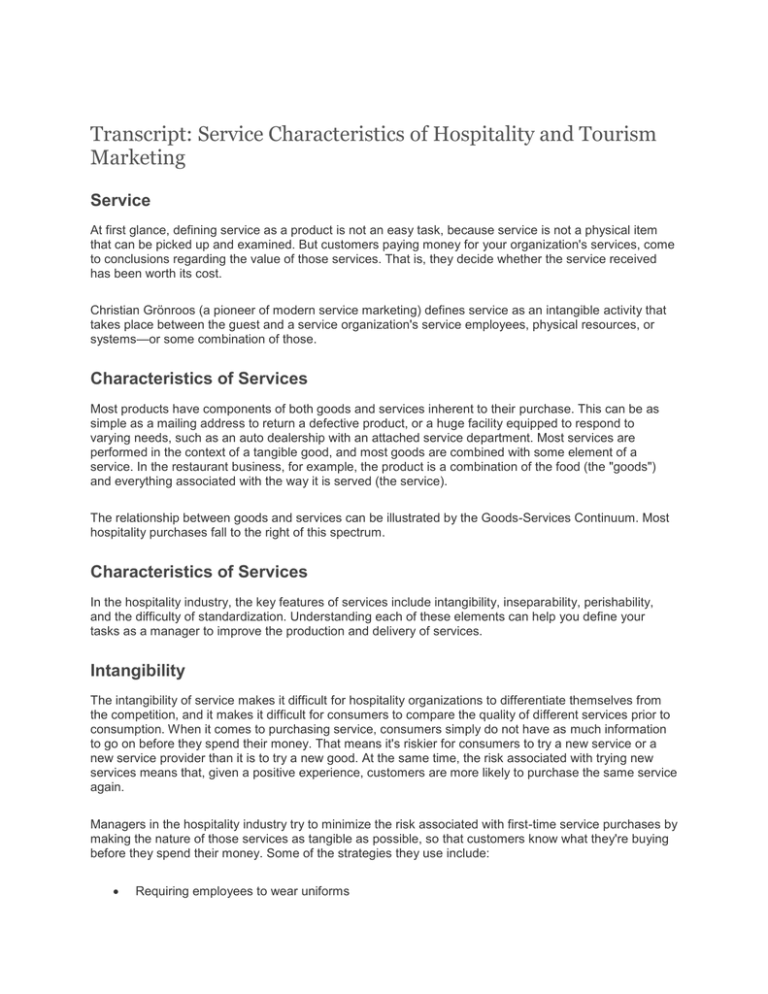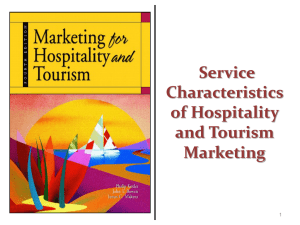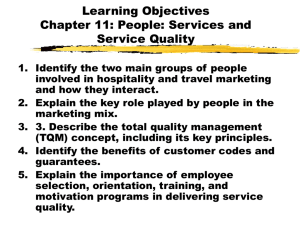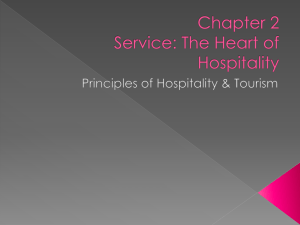service_characteristics_of_hospitality_and_tourism_marketing
advertisement

Transcript: Service Characteristics of Hospitality and Tourism Marketing Service At first glance, defining service as a product is not an easy task, because service is not a physical item that can be picked up and examined. But customers paying money for your organization's services, come to conclusions regarding the value of those services. That is, they decide whether the service received has been worth its cost. Christian Grönroos (a pioneer of modern service marketing) defines service as an intangible activity that takes place between the guest and a service organization's service employees, physical resources, or systems—or some combination of those. Characteristics of Services Most products have components of both goods and services inherent to their purchase. This can be as simple as a mailing address to return a defective product, or a huge facility equipped to respond to varying needs, such as an auto dealership with an attached service department. Most services are performed in the context of a tangible good, and most goods are combined with some element of a service. In the restaurant business, for example, the product is a combination of the food (the "goods") and everything associated with the way it is served (the service). The relationship between goods and services can be illustrated by the Goods-Services Continuum. Most hospitality purchases fall to the right of this spectrum. Characteristics of Services In the hospitality industry, the key features of services include intangibility, inseparability, perishability, and the difficulty of standardization. Understanding each of these elements can help you define your tasks as a manager to improve the production and delivery of services. Intangibility The intangibility of service makes it difficult for hospitality organizations to differentiate themselves from the competition, and it makes it difficult for consumers to compare the quality of different services prior to consumption. When it comes to purchasing service, consumers simply do not have as much information to go on before they spend their money. That means it's riskier for consumers to try a new service or a new service provider than it is to try a new good. At the same time, the risk associated with trying new services means that, given a positive experience, customers are more likely to purchase the same service again. Managers in the hospitality industry try to minimize the risk associated with first-time service purchases by making the nature of those services as tangible as possible, so that customers know what they're buying before they spend their money. Some of the strategies they use include: Requiring employees to wear uniforms Employing the same logo, building design, and façade on all buildings Making certain features (such as lobbies) visible, recognizable, and attractive Creating outward identifying signs and signifiers at every opportunity Inseparability Inseparability means that the production and consumption of services are tied together and often occur simultaneously. In the hospitality setting this often involves interactions between guest and clerk or guest and waiter; in such cases, there are usually several well-defined points of contact. These moments of personal contact between employees and guests are very important in the effectiveness of the service delivered. The interaction between the employee and the guest is part of the total product. Proper training and proper attention to detail are essential to ensure a successful interaction between guest and employee. Perishability When it comes to most tangible goods, items not sold today will keep their value and can be sold tomorrow. But certain goods are perishable--fruit, for example, ripens and has retail value for a limited window of time. The service-related efforts of your staff are similar in that they cannot be stored or saved. To manage a facility and staff profitably and ensure customer satisfaction, managers in the hospitality industry must be aware of such perishability and manage their capacity accordingly. The value of a room carried vacant tonight can never be realized in a future time period. To guard against this, hotels (and often airlines) frequently overbook their facility. If this is a regular business practice within your firm, then it's important to develop a process for finding alternate accommodations when guests walk in and discover their rooms have been given away. Difficulty of Standardization It is difficult to ensure consistent quality in the service industries because of the human element involved in the service production. Highly standardized behavior is almost impossible and not always desirable. Still, employees must be managed so that they provide a level of service that meets customer expectations and is commensurate with the corporate image. There are a wide variety of tactics used by the hospitality and tourism industry to manage the difficulty of standardization including: Increasing automation of tasks (electronic check in/out) Training employees to make good decisions Empowering employees to make those decisions Nonetheless, one of the more frustrating aspects of the service industry is that regardless of the employees' best efforts, ill-natured guests will probably not have a good experience.





